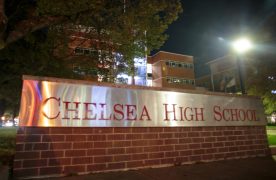Fire damage at Boston University is usually far less expensive than the 2009 Warren Towers fire that cost Boston University more than half a million dollars, a spokesman said.
On April 25, 2009, an electrical fire in Warren’s primary switchgear short-circuited, causing the power to go out in one of the towers. The initial cost estimate in 2009 was $300,000, but the final cost was a much higher $548,775.
“It is unusual to have something of that magnitude,” said BU spokesperson Colin Riley. “But there was a lot of electricity and very expensive equipment. It was really the cost of the equipment along with the fact that the transformer had to be replaced that caused a lot of the charges.”
“We also had to pay the generators so the building could have temporary power,” Riley said. “And the costs of police and fire response, but the switch gear was mostly covered by insurance.”
The total fire damage costs at BU in 2009 were more than $600,000, according to BU’s annual Security and Fire Safety Report, released on Oct. 4.
Starting in 2009, colleges have been required by the Campus Fire Safety Right-to-Know Act to publicly display fire statistics in order to promote campus fire safety.
The Right-to-Know Act, signed into law by President George W. Bush in 2008, was created to require universities to publish fire safety information and statistics.
This information is used to notify prospective and current students of the fire safety records at a university.
The act requires schools to annually report the number and causes of each fire, the number of injuries and deaths related to fires and the value of property damage caused by fires.
“Thanks to the act, schools are now required to report fire data which will help overall in improving fire safety,” said Paul Martin, president of the Center for Campus Fire Safety.
The Center for Campus Fire Safety is a non-profit organization aimed at reducing the loss of life from fires at universities and promoting fire safety.
“Unfortunately, fire damage like this happens quite a bit in universities, more often than the schools would like to believe,” Martin said. “We’ve been helping to train fire marshals to train students how to handle fires so cases like these are less likely.”
The CCFS has fire data dating back to the year 2000 on their website, where they let school fire marshals and other representatives publish college fire statistics, Martin said.
BU does not publish their statistics on campusfiredata.org, but Boston College and Tufts University are two of the many schools that do, he added.
The Princeton Review also rates schools’ fire safety on a scale of 60 to100. BU’s rating is 60, the lowest score possible, due to inadequate supply of information.
“We’ve gained a lot in the past few years of training kids to be more fire cautious,” Martin said. “But this kind of information is still new to us.”
Students offered a mixed reaction to BU’s fire record.
“I feel safer knowing that they are publishing the statistics now because it will encourage the school to set more precautions for fire safety in the future,” said Kelly Martin, a freshman in the College of Arts and Sciences.
Still, at least one student said he wished the school put more effort into publicizing the data.
“I feel less confident now about living here and wish that the school would publish the fire statistics somewhere where a wider audience could view them. Not just in a handbook that no one is going to read,” said Zach McClain, a freshman in the School of Management.
This is an account occasionally used by the Daily Free Press editors to post archived posts from previous iterations of the site or otherwise for special circumstance publications. See authorship info on the byline at the top of the page.












